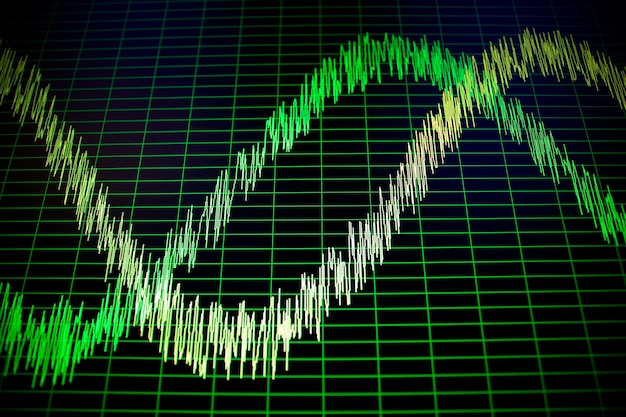Investing for Beginners: Read Stock Charts & Spot Opportunities

Investing for beginners involves understanding how to read a stock chart to identify potential opportunities by analyzing historical price movements, volume, and various technical indicators, aiding in making informed investment decisions.
Embarking on your investment journey can feel like navigating a complex maze. The stock market, with its fluctuating figures and intricate charts, might seem daunting at first. However, understanding how to read a stock chart is a crucial skill for any aspiring investor. Learning to decipher these charts can empower you to identify potential opportunities and make more informed investment decisions. This guide will provide investing for beginners with the knowledge needed to navigate the world of stock charts.
Understanding Stock Charts: A Beginner’s Guide
Stock charts are visual representations of a stock’s price movement over a specific period. They provide a historical overview of the stock’s performance, allowing investors to analyze trends, patterns, and potential future movements. Learning to interpret these charts is a fundamental skill for making informed investment decisions.
Understanding the basic components of a stock chart is essential before diving into more complex analysis. These components include the axes, price bars or candlesticks, volume indicators, and timeframes.

Basic Components of a Stock Chart
- Axes: The x-axis represents time, while the y-axis represents the price of the stock.
- Price Bars/Candlesticks: These display the opening, closing, high, and low prices for a specific period. Candlesticks are particularly useful as their color (usually green or red) indicates whether the closing price was higher or lower than the opening price.
- Volume Indicators: Volume represents the number of shares traded during a specific period, often displayed as bars at the bottom of the chart. Higher volume can indicate stronger interest in the stock.
- Timeframes: Charts can display data over various timeframes, such as daily, weekly, monthly, or even intraday. Choosing the appropriate timeframe depends on your investment strategy.
By understanding these basic components, beginners can start to grasp the information presented on a stock chart and begin to make informed decisions.
Deciphering Candlestick Patterns
Candlestick patterns are visual representations of price movements that can provide insights into market sentiment and potential future price action. These patterns are formed by the relationship between the opening, closing, high, and low prices for a given period.
Learning common candlestick patterns can help investors identify potential buying or selling opportunities. Some of the most widely recognized patterns include the Doji, Hammer, Engulfing Pattern, and Shooting Star.
Common Candlestick Patterns to Know
- Doji: A Doji forms when the opening and closing prices are nearly equal, indicating indecision in the market.
- Hammer: This pattern appears at the bottom of a downtrend and suggests a potential reversal. It has a small body and a long lower shadow.
- Engulfing Pattern: This pattern consists of two candlesticks, where the second candlestick completely “engulfs” the body of the first. A bullish engulfing pattern appears in a downtrend and signals a potential reversal, while a bearish engulfing pattern appears in an uptrend and signals a potential reversal.
- Shooting Star: A shooting star appears at the top of an uptrend and signals a potential reversal. It has a small body and a long upper shadow.
Recognizing these patterns can provide early signals of potential trend changes, allowing investors to react accordingly. However, it’s important to note that candlestick patterns should be used in conjunction with other indicators and analysis techniques to confirm signals.

Using Moving Averages to Identify Trends
Moving averages (MAs) are widely used technical indicators that smooth out price data by calculating the average price over a specific period. They help to identify the direction of the trend and potential support and resistance levels. Simple Moving Averages (SMA) and Exponential Moving Averages (EMA) are two common types.
Moving averages smooth out price fluctuations, making it easier to see the underlying trend. A rising moving average indicates an upward trend, while a falling moving average indicates a downward trend.
Applying Moving Averages
- Simple Moving Average (SMA): Calculated by adding the closing prices for a specific period and dividing by the number of periods.
- Exponential Moving Average (EMA): Gives more weight to recent prices, making it more responsive to current price movements.
- Crossovers: When a shorter-term moving average crosses above a longer-term moving average, it can signal a potential buying opportunity. Conversely, when a shorter-term moving average crosses below a longer-term moving average, it can signal a potential selling opportunity.
Moving averages are versatile tools that can be used in various ways to identify and confirm trends. However, like all technical indicators, they should be used as part of a comprehensive analysis strategy rather than relying on them in isolation.
Volume Analysis: Confirming Price Movements
Volume represents the number of shares traded during a specific period and is a key indicator of market activity and interest in a stock. Analyzing volume can help confirm the strength of price movements and identify potential trend reversals.
Volume provides additional insights into the conviction behind price movements. High volume during a price increase suggests strong buying pressure, while high volume during a price decrease suggests strong selling pressure.
Consistent increases in volume during an uptrend can confirm the strength of the trend, while a decrease in volume may indicate weakening momentum. Similarly, a spike in volume during a reversal can signal a significant shift in market sentiment.
Recognizing Support and Resistance Levels
Support and resistance levels are price levels where a stock tends to find support (buying interest) or resistance (selling pressure). These levels are important for identifying potential entry and exit points for trades and can be identified by analyzing stock charts for areas where the price has previously stalled or reversed.
Support levels are price levels where the stock has previously bounced upward, indicating buying interest. Resistance levels are price levels where the stock has previously stalled or reversed downward, indicating selling pressure.
Identifying these levels involves looking for areas on the chart where the price has repeatedly reversed direction. Trendlines can also be used to identify dynamic support and resistance levels.
Technical Indicators: Enhancing Your Analysis
Technical indicators are mathematical calculations based on price and volume data that can provide additional insights into market trends, momentum, and volatility. These indicators can help investors make more informed decisions.
Several popular technical indicators can be used to enhance your analysis. These include the Relative Strength Index (RSI), Moving Average Convergence Divergence (MACD), and Bollinger Bands.
Popular Technical Indicators:
- Relative Strength Index (RSI): Measures the magnitude of recent price changes to evaluate overbought or oversold conditions in the price of a stock or other asset. An RSI above 70 indicates overbought conditions, while an RSI below 30 indicates oversold conditions.
- Moving Average Convergence Divergence (MACD): A trend-following momentum indicator that shows the relationship between two moving averages of a security’s price. It can be used to identify potential buying or selling signals.
- Bollinger Bands: These consist of a middle band (usually a 20-day moving average) and two outer bands plotted at a standard deviation above and below the middle band. They can be used to identify periods of high and low volatility.
Using technical indicators can provide additional confirmation of potential trading opportunities. However, it’s important to use them in conjunction with other analysis techniques and to understand their limitations.
Putting It All Together: A Practical Approach
Analyzing stock charts involves combining different techniques and indicators to form a comprehensive view of a stock’s potential. This practical approach includes identifying the trend, recognizing patterns, confirming with volume, and setting realistic targets.
The key to successful chart analysis is to integrate different techniques and indicators to confirm potential trading opportunities. Start by identifying the overall trend using moving averages, then look for candlestick patterns and support/resistance levels. Confirm your analysis with volume and use technical indicators to fine-tune your entry and exit points.
Stock charts provide valuable insights into market sentiment and potential future price movements, but they are not foolproof. By combining chart analysis with fundamental analysis and risk management, investors can improve their chances of success in the stock market.
| Key Concept | Brief Description |
|---|---|
| 📈 Stock Charts | Visual representations of a stock’s price movement over time. |
| 📊 Candlestick Patterns | Visual patterns that provide insights into market sentiment and potential price action. |
| 📉 Moving Averages | Help identify the direction of the trend and potential support and resistance levels. |
| 💰 Volume Analysis | Confirms the strength of price movements and identifies potential trend reversals. |
Frequently Asked Questions (FAQs)
▼
A stock chart is a visual representation of a stock’s price over a certain period, helping investors analyze its historical performance and predict potential movements using technical indicators.
▼
Candlestick patterns are formed by the opening, closing, high, and low prices for a given period. Common patterns like the Doji, Hammer, and Engulfing Pattern can signal market sentiment and potential reversals.
▼
Moving averages smooth out price data over a specific period, helping to identify the direction of the trend. Rising moving averages suggest an upward trend, while falling ones indicate a downward trend.
▼
Volume analysis confirms the strength of price movements. High volume during a price increase indicates strong buying pressure, and high volume during a decrease indicates strong selling pressure.
▼
Support levels are price levels where a stock typically finds buying interest, and resistance levels are where it encounters selling pressure. These levels help identify potential entry and exit points.
Conclusion
Understanding how to read a stock chart is a valuable skill for any beginner investor. By learning the basic components, recognizing candlestick patterns, and utilizing technical indicators, you can gain insights into market trends and potential investment opportunities. Always remember to combine chart analysis with other forms of analysis and practice risk management to make informed decisions in the stock market.